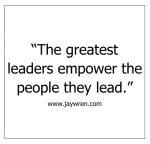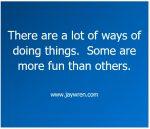Empowering Teams: How Leaders Create Success. When a team performs below the sum of its members’ abilities, has leadership failed?
“The greatest leaders empower the people they lead.” www.jaywren.com
Empowering Teams: Leaders use different methods to create powerful teams and reduce turnover. Here are some simple steps that any leader can use.
Empowering Teams: How Leaders Create Powerful Teams and Reduce Turnover.
Leaders use different methods to create powerful teams and reduce turnover. Here are some methods that simply work.
Keep an open door with your team members.
It is one thing to ask your team members to respect your time. It is quite another to block them off just because you can’t be bothered.
Encourage your team members to give you feedback and updates. Set up a list of things that they must tell you about no matter what.
Give directions that can’t be misunderstood.
Tell the people what you want them to do. Then ask them to tell you what they understand about what you have told them.
Having your team members do work that does not achieve the goals, only to have to do it again, frustrates them.
Giving them clear direction helps them be more successful and feel engaged and successful.
Text and Email with a Purpose.
Before you send a text or an email, write down the purpose of the message.
Use Critiques to Increase Competence.
Finding fault just discourages your team. Take a minute to make sure that they understand what you expect them to do.
Criticism creates stress. Helpful, clear direction creates engagement and increases competence.
Give Progress Updates and Interim Encouragement.
Check the progress your team is making on projects. Update the team members with changes and corrections as work progresses. Encourage team members to continue the good work they are doing.
Delegate, but don’t abdicate.
Empower team members to make decisions. State clearly how much authority that they have and how you expect them to use that authority.
However, don’t just assume that they will do everything the way you expect. Check in with them often to encourage them and to keep them focused.
Use Emotional Intelligence as a Tool for Success.
Emotional Intelligence is the process of responding with intelligence and giving direction based on the best interest of the business. It is easy to let your ego take over and run roughshod over your team members.
Sometimes, you must be firm. However, angry outbursts don’t work effectively with every team member.
Carefully gauge how you respond emotionally based on the conditions and based on the emotional intelligence of the team member.





